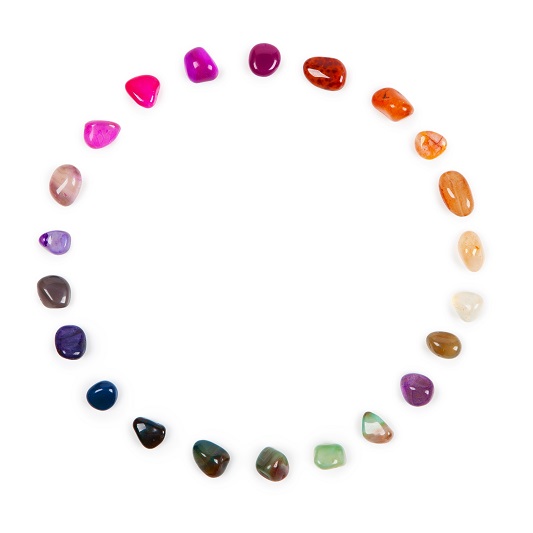Labradorite Gemstone of the Week

Corundum Gemstone of the Week
16th February 2018
Malachite, Gemstone of the Week
28th February 2018A variety of plagioclase feldspar, Labradorite is famous for its colourful iridescence. The stone is named after Labrador in Canada, where it was first discovered in 1770. Since the initial discovery of the stone, deposits have been found in various other locations around the world, including Madagascar, Australia, and the USA. The iridescent surface of the stone makes it appear a variety of different colours. This phe-nomenon is often referred to as ‘labradorescence’, and is believed to be caused by the diffraction of light in layers of the stone. Inuit legend suggests that Labradorite captured the Northern Lights after they shone down on the stone from the coast of Canada. While all specimens of Labradorite are seen as being gem-quality, the highest valued specimens are those that exhibit a full spectrum of colours. However, any specimen that shows labradoresence is sought after, and popularly used in gemstone jewellery. In this article, we explore Labradorite in more detail.
How to Identify Labradorite
For the trained professional, identifying Labradorite is fairly simple. Typically, the gem is identified by iri-descent appearance, which is often referred to as it’s ‘labradorescence’. The effect means that the stone exhibits a range of different colours. Labradorescence is caused by the diffraction of light in different lay-ers of the rock. Occasionally, specimens of Labradorite can also exhibit adularescence; this is best de-scribed as a pale blue light seen when the stone is rotated. This effect may cause the stone to be mistak-en for Moonstone. However, true Moonstone can be distinguished by its low density and monoclinic crystals.
Labradorite can also be mistaken for various other gems such as Albite, Oligoclase, Andesine, Bytownite, and Anorthite. However, the double refraction of Albite is much higher than Labradorite, whilst the re-fraction of Oligoclase and Andesine is much lower. Labradorite can often be distinguished from Bytownite by it’s darker colour scheme; Bytownite usually appears transparent, white, or grey, whilst Labradorite is usually grey to black. Typically, Anorthite is transparent and has a higher double refraction than Labrador-ite.
Different Colours and Types of Labradorite
Typically, Labradorite is grey or black in colour and boasts a beautiful iridescence or ‘labradoresence’ as it is commonly referred to as. As mentioned previously, this phenomenon is caused by the diffraction of light in different layers of the stone. Although the most common colours of Labradorite are grey and black, the exact colour of each specimen will vary. The gemstone can also appear orange, blue, and brown in colour. Royal blue specimens typically hold the highest value.
When it comes to cutting the stone, Labradorite is usually cut en cabochon to maximize the iridescence. However, when the stone is used within gemstone jewellery it is often cut into extravagant shapes, in-stead. For instance, the gem is cut into spherical shapes when used for beaded bracelets. Unlike many types of precious stone, Labradorite is rarely treated or enhanced.
Where is Labradorite Found?
Today, the main source of Labradorite is still Canada, with large deposits occurring in Labrador and New-foundland. Specimens are also found in various other locations worldwide. Notable sources include Mad-agascar, Russia, Mexico, Australia, and the USA.
Healing Properties of Labradorite
Like many precious stones, Labradorite is popular for use within crystal healing. Many people believe that the Northern Lights are captured in the beautiful stone, which isn’t surprising when you think about the stones magical iridescence. Often seen as the stone of protection, Labradorite is thought to hold protec-tive properties that keep its beholder healthy and safe. Additionally, the stone is believed to help individ-uals find their true calling in life. Thought to ‘bring light’ to the unknown, the stone provides the beholder with insight to help them make the correct choices. Helping to soothe the over-active mind, the stone may benefit those suffering from insomnia. Labradorite can also help sufferers of Anxiety; bringing peace to the mind, the stone can help the beholder to think rationally.
Physically, Labradorite is believed to relieve menstrual discomfort and regulate the female cycle. Addi-tionally, the stone is thought to combat diseases of the lungs, prevent the common cold, and regulate blood pressure. Also thought to improve digestion, the stone may benefit those suffering from digestive conditions such as Irritable Bowel Syndrome, Inflammatory Bowel Disease, and Crohn’s.
In crystal healing, Labradorite is associated with the throat chakra. Linked to our hearing, speech, and self-expression, the throat chakra is often referred to as ‘the centre of purification’. Those that wear Labra-dorite are believed to benefit from honest self-expression. Spiritually, Labradorite is thought to connect the physical and spiritual world. Wearing the stone is thought to help the beholder remember their dreams and even their experiences from previous lives. With this in mind, the stone is popular amongst those hoping to improve their psychic abilities.
In Summary
Colourful Labradorite is popular worldwide. Today, the most notable deposits of the stone are still found in Canada, though specimens can also be found in Madagascar, Russia, Mexico, Australia, and the USA, too. Loved for its beautiful iridescence, good-quality Labradorite is often used in designer jewellery. Whether you’re hoping to use the stone for its benefits within crystal healing or you’re looking for a beau-tiful new addition to your jewellery collection, purchase a good-quality piece of Labradorite to reap the benefits.




